Layman D. Biology Demystified: A Self-Teaching Guide
Подождите немного. Документ загружается.

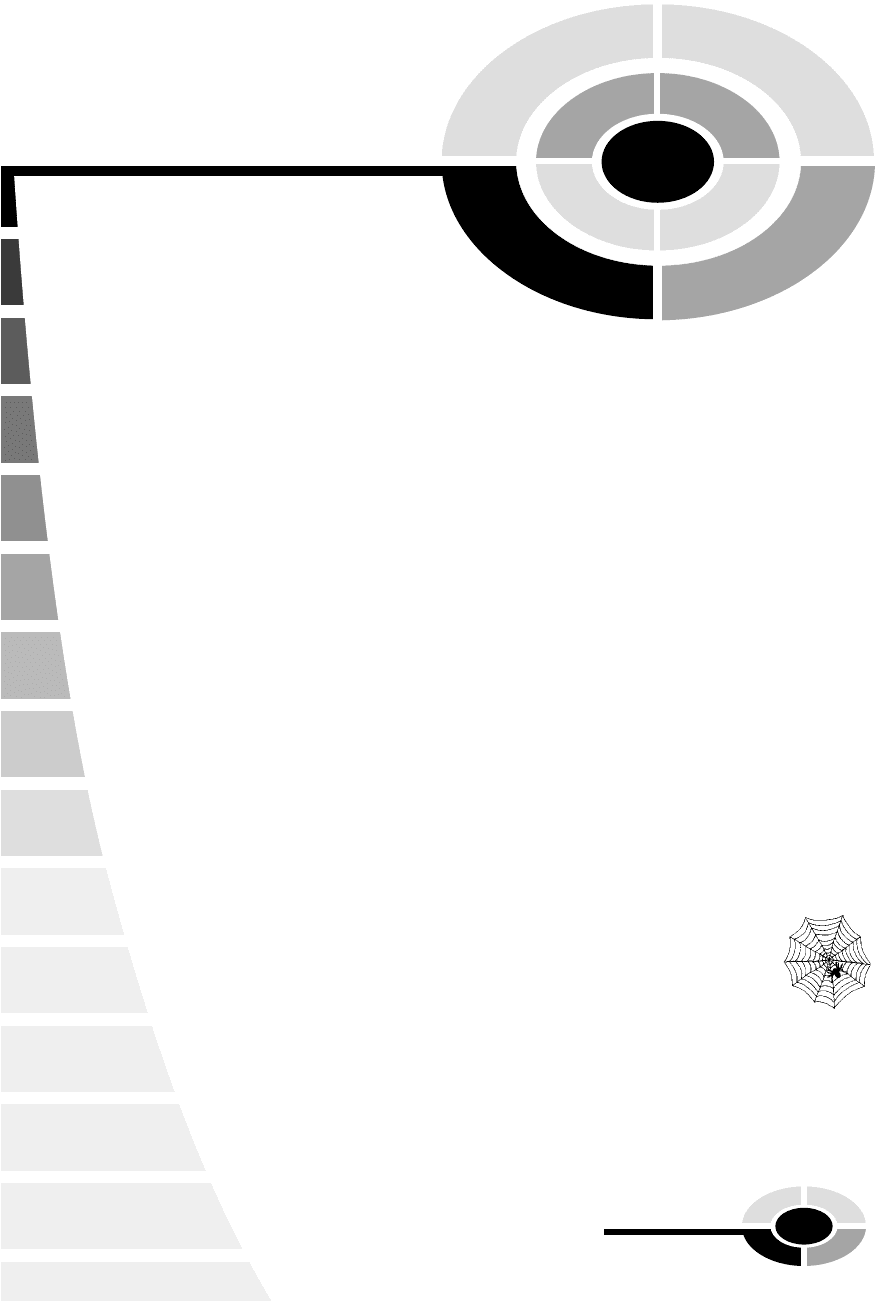
[13:25 13/6/03 N:/4058 LAYMAN.751/4058-Alltext.3d] Ref: 4058 Layman: Biology Demystified All-text Page: 177 1-388
177
CHAPTER
11
The Arthropods: No
Jointed Backbone,
but ‘‘Jointed Feet’’
Chapter 10 introduced us to the invertebrates – the animals ‘‘without’’ (in-)
‘‘jointed backbones’’ (vertebr). Technically, the backbones are called the
vertebrae (VER-tuh-bray). Humans and other vertebrates contain such
jointed backbones that support their body weight.
This chapter now introduces another group of invertebrates – the arthro-
pods (AR-thruh-pahds). Arthropods, like other invertebrates, contain no
jointed backbones. But they are set distinctly apart, however, by their
‘‘jointed’’ (arthro-) ‘‘feet’’ (pod)!
1, Web
Copyright 2003 by The McGraw-Hill Companies, Inc. Click Here for Terms of Use.

Common Characteristics of the Arthropods
As Figure 11.1 shows, the general body plan shared by all arthropods can be
represented by the anatomy of a lobster. The arthropods are a huge phylum of
invertebrates with bilateral symmetry whose bodies are clearly divided into
jointed segments, and whose legs are hollow and also divided into jointed
segments. Possessing bilateral symmetry, the arthropods have pairs of match-
ing right–left antennae (an-TEN-ee) or feelers, legs, and in many insects,
wings.
THE SEGMENTED BODY
The lobster is covered by a hard exoskeleton (eks-oh-SKEL-eh-ten) – an
‘‘outer’’ (exo-) ‘‘hard dried body’’ (skeleton). Since the exoskeleton is on
[13:25 13/6/03 N:/4058 LAYMAN.751/4058-Alltext.3d] Ref: 4058 Layman: Biology Demystified All-text Page: 178 1-388
PART 3 Five Kingdoms of Life, plus Viruses
178
Fig. 11.1 The lobster body as a typical arthropod.
1, Order

the surface of the animal, it is also called the cuticle (KYOO-tih-kl) or ‘‘little
skin.’’ The exoskeleton (cuticle) can even be thought of as a ‘‘coat of mail,’’ a
type of armor! Why is this? The reason is that the lobster exoskeleton con-
tains large amounts of chitin (KY-tin). Chitin also covers the surfaces of
crabs, beetles, and crickets. Chitin is a tough, horny substance providing
protection to the invertebrate body, much as if the lobster were an ocean-
dwelling knight wearing a ‘‘coat of mail’’ (chitin)!
The chitin-armored lobster body has two pairs of antennae (short and
long), two feeding mouthparts, as well as two large pincers, attached to either
side of the head. A thorax (THOH-racks) or ‘‘chest’’ piece forms a second
segment behind the head. The head and thorax are often lumped together by
biologists and named as a single large segment called the cephalothorax (sef-
uh-low-THOR-aks) or ‘‘head’’ (cephal)-and-‘‘chest’’ piece. Four hollow, seg-
mented legs are attached to either side of the cephalothorax and allow the
lobster to easily walk over the ocean floor.
Behind the thorax is the third body segment – a much-longer abdomen
(AB-duh-mun). The abdomen is literally the long ‘‘belly’’ of the beast. But for
we lobster-eating humans, it is usually just considered the tail! The exoske-
leton protecting the abdomen is subdivided into a number of hinged plates,
allowing the lobster to use its swimming appendages (uh-PEN-dih-jes) or
‘‘hangers-on’’ to scoot its body rapidly along.
AN OPEN-ENDED CIRCULATORY SYSTEM
Arthropods do have hearts, but these hearts pump a fluid called hemolymph
(HE-moh-limpf), rather than blood. The circulatory system is an open one.
This means that the heart pumps the hemolymph into vessels and sinuses
which are not closed off. Nevertheless, the hemolymph still provides the body
tissues with an adequate supply of oxygen and other nutrients.
A DEPENDENCE UPON MOLTING
Because many arthropods have a rigid exoskeleton, yet they continue to grow
in size throughout most of adulthood, they are forced to periodically molt
(MOHLT) or shed. After the exoskeleton is molted (shed), the lobster or
other arthropod is temporarily soft-bodied and vulnerable to hungry preda-
tors. But the head of the lobster bears two eyes, each perched upon a movable
stalk, that lets it readily see approaching predators (and hopefully escape
being eaten!).
CHAPTER 11 The Arthropods 179
[13:25 13/6/03 N:/4058 LAYMAN.751/4058-Alltext.3d] Ref: 4058 Layman: Biology Demystified All-text Page: 179 1-388
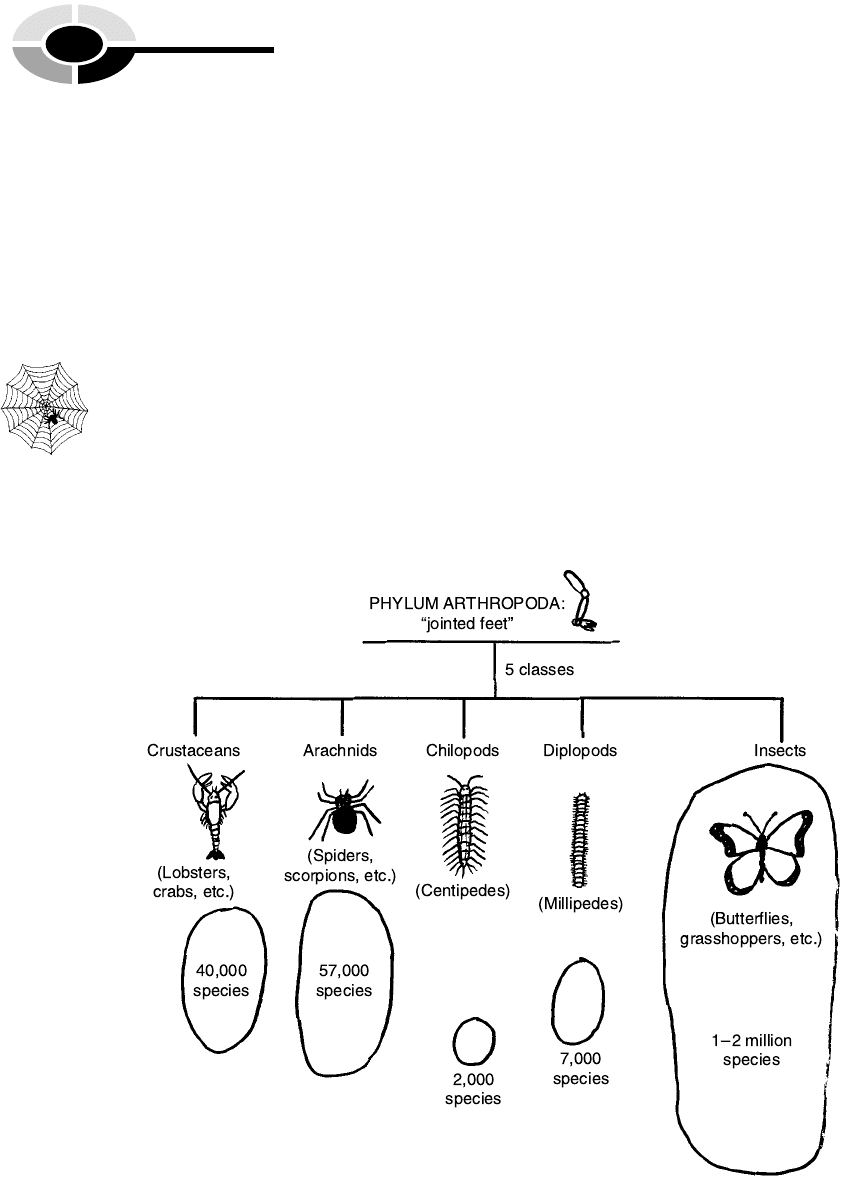
Major Types of Arthropods
There are several major types or categories of arthropods. The first question
a person might ask, however, is: ‘‘The arthropods are all invertebrates. So,
why weren’t they included within Chapter 10, which described the inverte-
brates?’’ [Study suggestion: Take a careful look at Figure 11.2. What parti-
cular feature really sticks out at you? How do you think this feature explains
why arthropods are placed in a separate chapter of their own?]
Using a traditional approach to taxonomy, there is a single phylum
Arthropoda (ar-THRAH-pah-da), subdivided into five smaller classes.
These are the Crustaceans (krus-TAY-shuns), Arachnids (ah-RACK-nids),
Chilopods (KY-luh-pods), Diplopods (DIP-luh-pods), and Insects. In Figure
11.2, the relative size of each oval shape representing these arthropod classes
visually pictures the number of known species belonging to each one.
[13:25 13/6/03 N:/4058 LAYMAN.751/4058-Alltext.3d] Ref: 4058 Layman: Biology Demystified All-text Page: 180 1-388
2, Web
Fig. 11.2 The five major classes of arthropods.
PART 3 Five Kingdoms of Life, plus Viruses
180

ANCIENT TRILOBITES AND THE MODERN CRUSTACEANS
Let us begin our examination of the major arthropod classes with the crus-
taceans – invertebrates whose bodies are surrounded by hard ‘‘shells’’ (crus-
tace). In the modern world, the crustaceans include crabs, lobsters, crayfish,
and shrimp. Besides their hard shells (rigid exoskeletons), these crustaceans
have jointed bodies and legs, as well as gills that allow them to exchange their
hemolymph gases with the external gases in the surrounding water.
There are now about 40,000 known species of crustaceans, most of them
living within either freshwater or saltwater environments. Yet, biologists
have repeatedly observed an early ancestor (long extinct) of the modern
crustaceans in the Fossil Record. This extinct group of arthropods is the
trilobites (TRY-loh-bites). The trilobites consisted of about 4,000 species,
and they were very abundant in the sea during the Paleozoic Era (Chapter
3). The trilobites had bodies comprised of ‘‘three’’ (tri-) vertical ‘‘lobes’’ (lob)
subdivided into many horizontal segments (Figure 11.3). Sprouting from
either side of the body segments were numerous jointed legs. But unlike
the modern lobster and other crustacea, these ancient marine invertebrates
had appendages running along either side of their body that showed very
little difference or specialization. For instance, they lacked the protective
pincers of present-day crabs and lobsters.
The trilobites rather suddenly became extinct about 250 million years ago,
near the end of the Paleozoic Era (shortly before the dinosaurs appeared
CHAPTER 11 The Arthropods 181
[13:25 13/6/03 N:/4058 LAYMAN.751/4058-Alltext.3d] Ref: 4058 Layman: Biology Demystified All-text Page: 181 1-388
Fig. 11.3 The three-lobed body of the ancient trilobite.
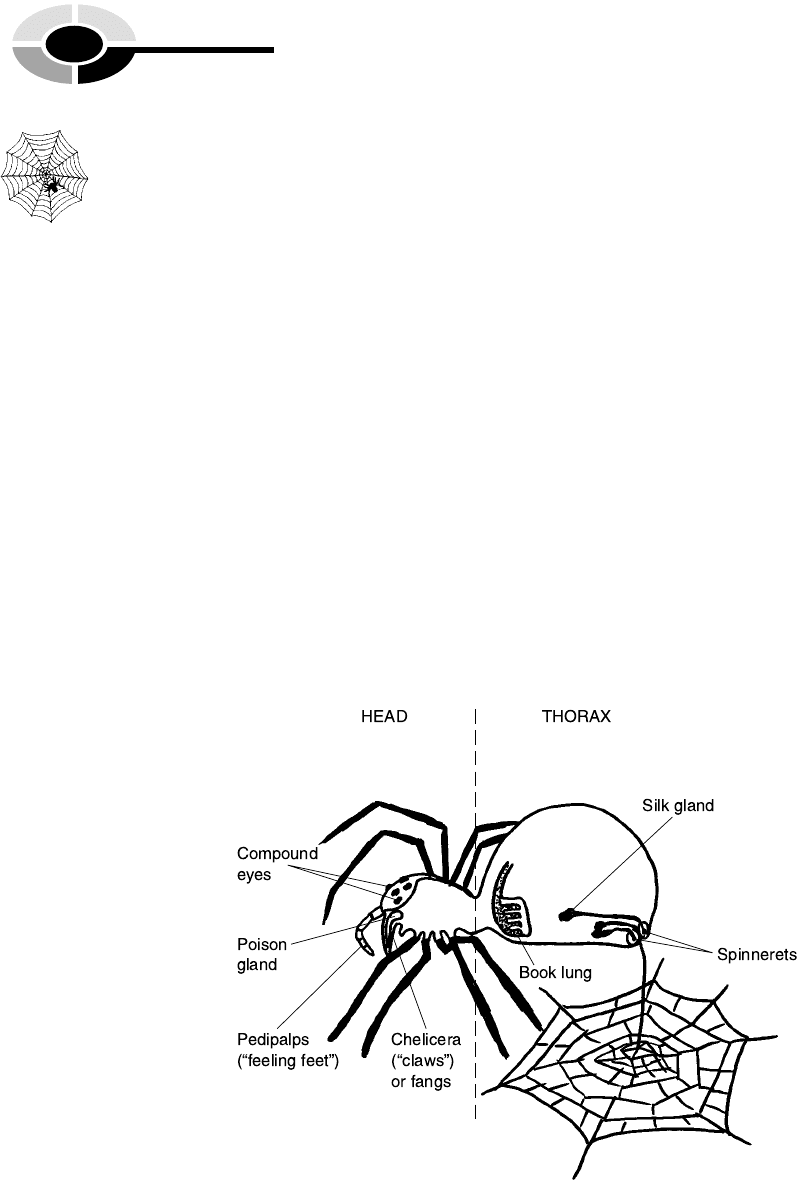
during the Age of Reptiles). Because they never reappear at later stages in the
Fossil Record, the limited time period of trilobite existence strongly supports
the concept that once a group of animals becomes extinct, they generally stay
extinct! There is a definite Biological Order or recognizable sequence of body
forms and patterns that seem to precede or follow one another during the
long time-scale of evolution.
THE ARACHNIDS: SPIDERS AND THEIR RELATIVES
The arachnids are literally ‘‘spiders or webs’’ (arachn). Besides the spiders,
however, the arachnids include scorpions, ticks, and mites as well. The
arachnid group includes about 57,000 species. The basic anatomy of the
arachnids is displayed within Figure 11.4. The spider body has two segments
– head and thorax (cephalothorax). Situated farthest in the front of the head
are the pedipalps (PED-uh-palps) and chelicera (kuh-LIS-er-ah). The
pedipalps are a pair of ‘‘feeling’’ (palp) ‘‘feet’’ (pedi) – small foot-like appen-
dages that help sense when prey is present. The chelicera or ‘‘claws’’ (cheli)
then come into play. The two chelicera serve much like fangs, injecting
poison from a gland just below the four eyes. The chelicera inject digestive
juices, as well as poison, into captured prey, which softens the attacked body
[13:25 13/6/03 N:/4058 LAYMAN.751/4058-Alltext.3d] Ref: 4058 Layman: Biology Demystified All-text Page: 182 1-388
PART 3 Five Kingdoms of Life, plus Viruses
182
Fig. 11.4 The amazing body of a spider.
3, Web
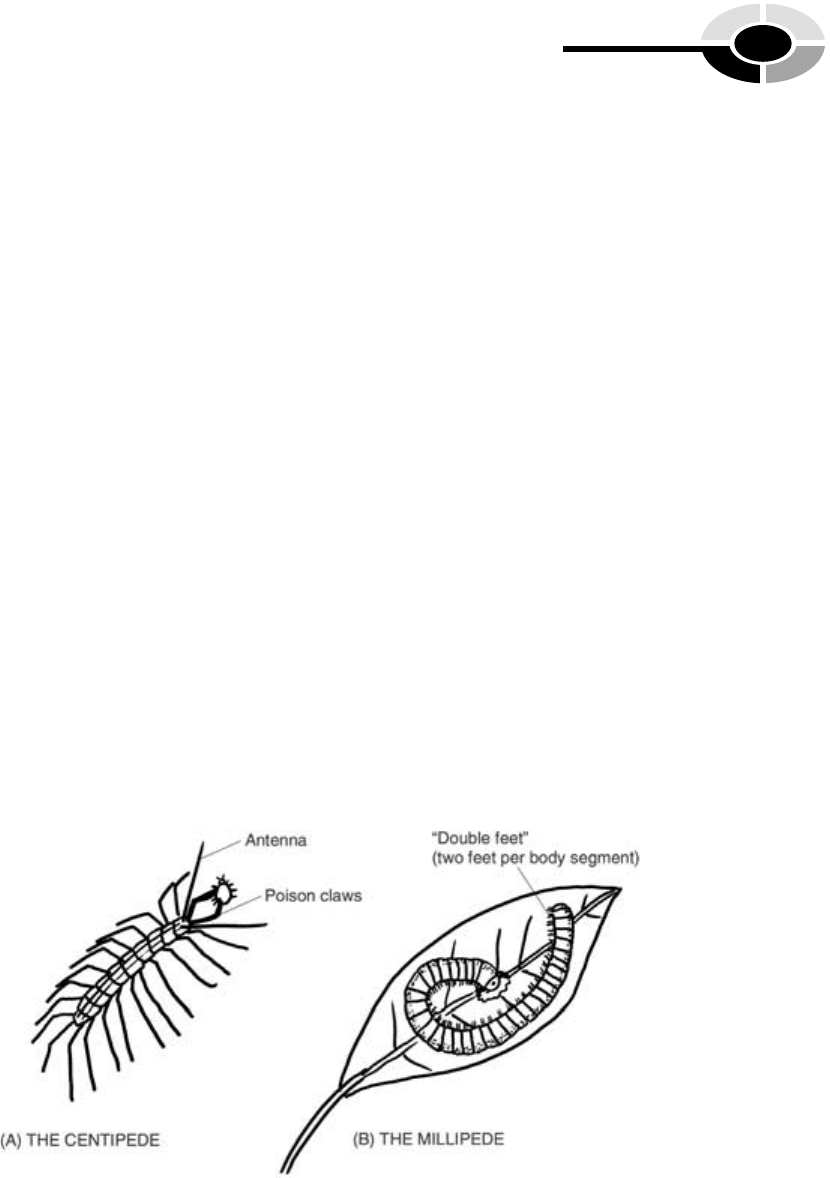
as well as killing it. The spider finally sucks the liquefied food into its diges-
tive system.
Along each side of the cephalothorax, spiders have four pairs of walking
legs. Other special characteristics include a stack of book lungs, as well as a
silk gland with spinnerets (SPIN-uh-rets) – small organs used for spinning
webs.
CENTIPEDES AND MILLIPEDES: ‘‘SO MANY LEGS!’’
The Chilopod class literally consists of arthropods with ‘‘lip’’ (chil) ‘‘feet’’
(pod), obviously named for their appearance. There are approximately 2,000
species in this group. The main Chilopods are the centipedes (SEN-tuh-peeds)
or organisms with a ‘‘hundred’’ (centi-) ‘‘feet’’ (ped). Centipedes are thin,
worm-like arthropods with segmented bodies having many pairs of legs
(but certainly not 100!). The centipede has very long antennae and poison
claws that catch smaller insects to eat (Figure 11.5, A).
The Diplopod class includes those creatures with ‘‘double’’ (dipl) ‘‘feet’’
(pod). About 7,000 species of Diplopods exist. True to their Class name, each
body segment bears two legs with feet. The primary Diplopods are the milli-
pedes (MIH-luh-peeds) – translated to mean arthropods with a ‘‘thousand’’
(milli-) ‘‘feet.’’ The millipede body, of course, has far fewer than 1,000 feet
(Figure 11.5, B)! Millipedes feed on moss, decaying leaves, and a variety of
other types of plant matter.
CHAPTER 11 The Arthropods 183
[13:25 13/6/03 N:/4058 LAYMAN.751/4058-Alltext.3d] Ref: 4058 Layman: Biology Demystified All-text Page: 183 1-388
Fig. 11.5 Centipedes and millipedes: So many legs!
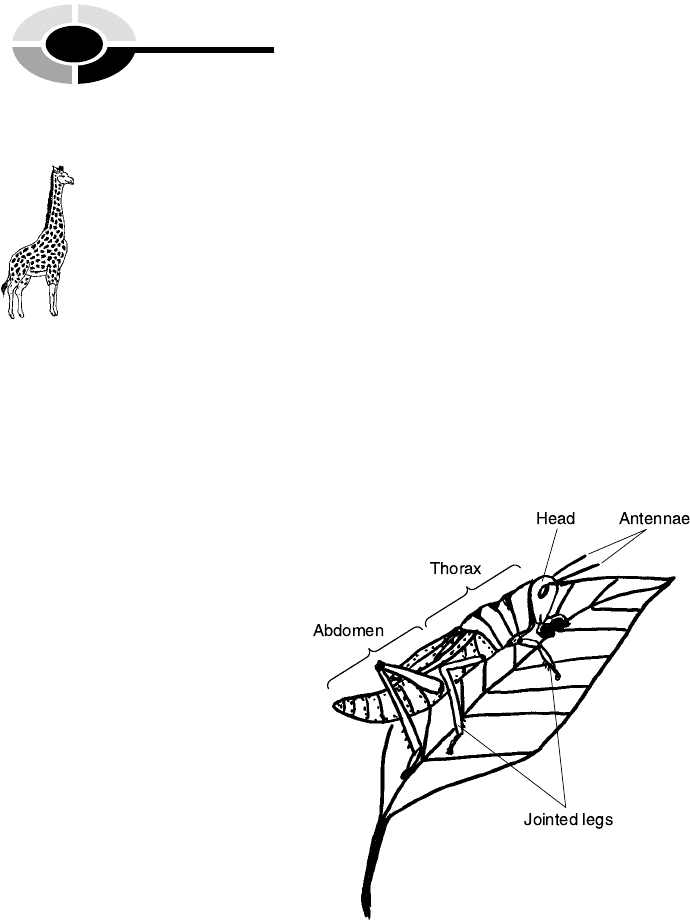
[13:25 13/6/03 N:/4058 LAYMAN.751/4058-Alltext.3d] Ref: 4058 Layman: Biology Demystified All-text Page: 184 1-388
INSECTS: THE SWARMING HERD
Of all the arthropods, the insects represent by far the hugest number of species
– at least one million known (and maybe another million or so insect species
still undiscovered, mainly within tropical forests)! This means that there are
more species of insects than species of all other types of animals, combined!
Yet, despite their overwhelming numbers and diversity, insects share a
common body plan (Figure 11.6). The word insect actually comes from the
Latin for ‘‘cut’’ (sect) ‘‘into’’ (in-). The reason for this name is that the body
of most insects is ‘‘cut’’ (subdivided) into three major segments. Using the
example of a grasshopper, there is a head, a thorax, and an abdomen. The
insect head bears two antennae and a pair of compound eyes. In their adult
stages, many insects have three pairs of jointed legs and either one or two
pairs of wings, all attached to the thorax.
Metamorphosis: A Caterpillar Becomes A
Butterfly
No doubt you have seen a humble caterpillar crawling slowly across a leaf.
But hidden from your gaze, at the end of summer the caterpillar begins to
PART 3 Five Kingdoms of Life, plus Viruses
184
Fig. 11.6 The grasshopper: An insect body plan.
2, Order
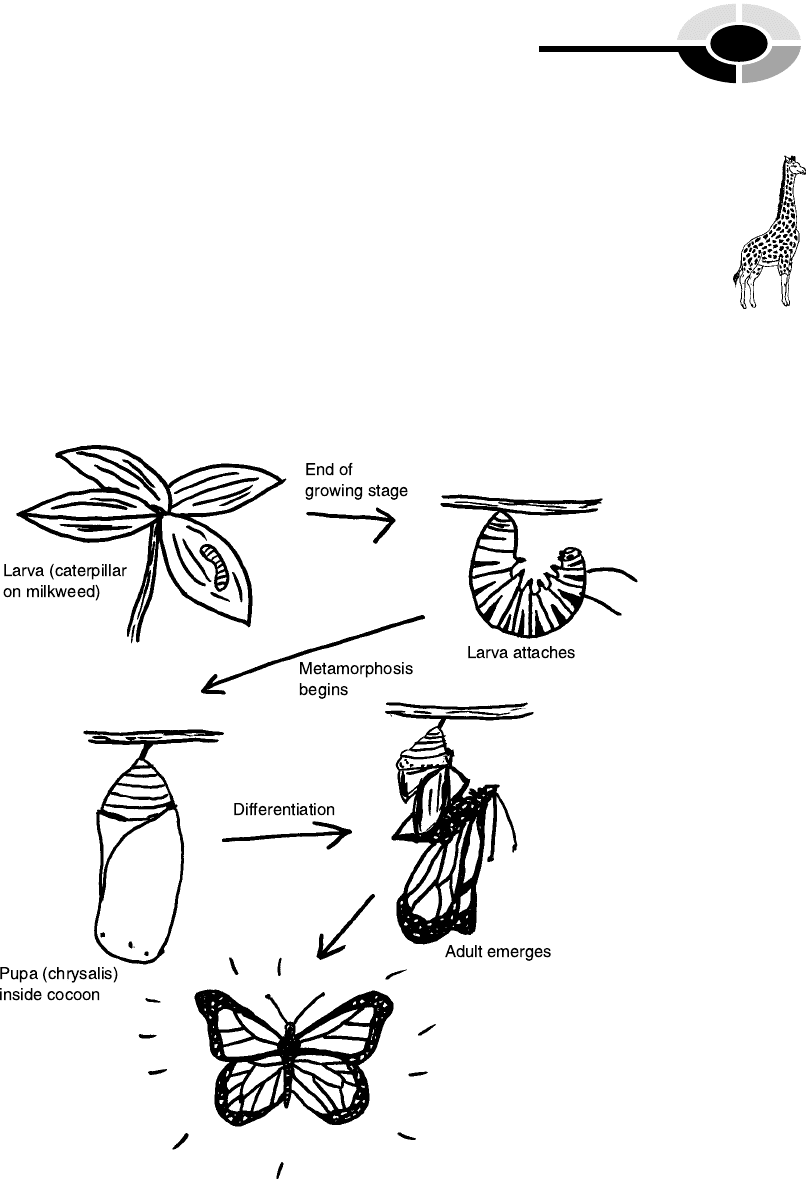
undergo a dramatic metamorphosis (met-uh-MOR-fuh-sis) – a ‘‘changing
over’’ (meta-) of its body shape or ‘‘form’’ (morph).
In most cases, metamorphosis is a mechanism whereby an embryonic stage
of an animal (such as an insect) changes into a strikingly different adult body
form. One of the most beautiful examples of metamorphosis is the transfor-
mation of a caterpillar into a gracious, delicate-winged butterfly. Some of the
major steps in this process are shown in Figure 11.7 for the well-known
monarch (MAHN-ark) butterfly. Like a king or queen or some other type
of ‘‘ruler-alone’’ (monarch) in the world, the adult monarch butterfly stands
alone in its striking orange-and-black body pattern.
CHAPTER 11 The Arthropods 185
[13:25 13/6/03 N:/4058 LAYMAN.751/4058-Alltext.3d] Ref: 4058 Layman: Biology Demystified All-text Page: 185 1-388
Fig. 11.7 Caterpillar into monarch: a striking metamorphosis.
3, Order

The process begins with a larva (caterpillar) stage. The black-striped mon-
arch caterpillar (larva) likes to feed on the milkweed plant, named for its
white, milky juice. The caterpillar just keeps gorging itself on milkweed leaves
and growing throughout the summer, molting its skin several times. Finally,
at the end of the growing stage, the caterpillar larva firmly attaches itself to a
branch. Here it molts several more times, then encases itself within a cocoon
(kuh-KOON). A cocoon is an external ‘‘shell or husk’’ of silky material that
caterpillars spin around themselves during their preparation for metamor-
phosis.
When the larva is encased within a tough, protective cocoon, its new stage
of development is called the pupa (PYOO-puh) or chrysalis (KRIS-uh-lis). In
Latin, chrysalis literally means ‘‘golden pupa of a butterfly.’’ Likewise, pupa
means ‘‘girl or doll.’’ So, the pupa (chrysalis) is poetically described as a
‘‘golden girl or doll’’ that will eventually mature into a queen-like, elegant
butterfly! Perhaps the reference to ‘‘golden’’ is due to the rather shiny appear-
ance of the outer wall of the cocoon enveloping the chrysalis (pupa).
Within the pupa, a precisely timed genetic program is now turned on. The
tissues of the larva are broken down, then replaced by other cells that
undergo mitosis and differentiation (dif-uh-ren-she-AY-shun) – ‘‘the process
of becoming different’’ or specialized. Certain body cells, for example,
migrate to the sides of the pupa in a bilaterally symmetrical manner. The
cells in these locations then differentiate (dif-uh-REN-she-ate) into the highly
specialized structures of the developing butterfly wings.
Soon after the arrival of spring, the adult begins to emerge from the
cocoon. At first, the wings are flat and wet and pressed against the sides of
the butterfly body. But a pumping process pushes fluid out into the veins of
the wings, stiffening and opening them. The result is a beautiful, orange,
black-striped, bilaterally symmetrical monarch butterfly – one of the most
impressive displays of Biological Order known to humankind!
Insects: Inducers of Biological Order and
Disorder In the Environment
Since there are more species of insects than all other types of animals com-
bined, a convincing argument can be made that insects (not human beings)
are the real ‘‘monarchs’’ (rulers) of this planet! Because of their sheer num-
bers, then, the World of Insects exerts a critical influence upon both
Biological Order, and Biological Disorder, within the ecosystem of the exter-
[13:25 13/6/03 N:/4058 LAYMAN.751/4058-Alltext.3d] Ref: 4058 Layman: Biology Demystified All-text Page: 186 1-388
PART 3 Five Kingdoms of Life, plus Viruses
186
4, Order
4, Web
